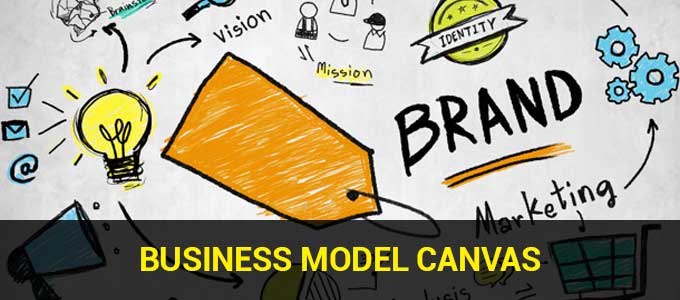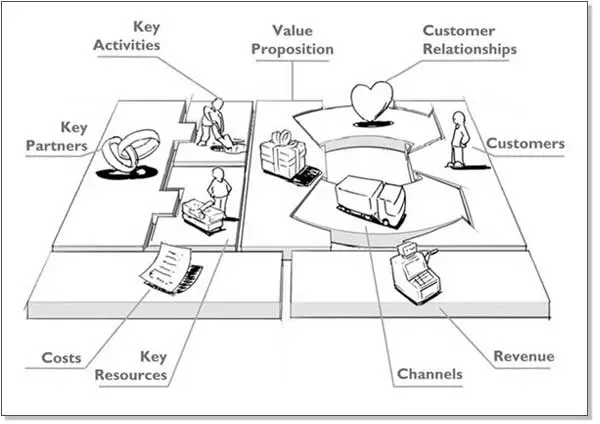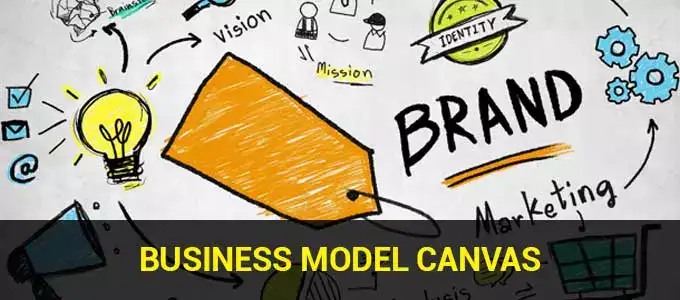
The Business Model Canvas (BMC) is a tool that entrepreneurs can use to create new businesses and also analyze existing businesses. The Business Model Canvas makes the business more structured so that it is easier to execute and develop.
Many business people only sell products/services without a clear concept. In the end, the business only runs for a moment and cannot sustain itself. Most of the entrepreneurs also feel ‘already smart’ so they no longer want to learn new things. They are trapped in daily operations and hardly ever think about their swot analysis business strategy.
The business model canvas complements the 4P (Place, Product, Price, Promotion) theory that is commonly used by business people. In the canvas business model, there are 9 building blocks that entrepreneurs must think about in order to see their business more comprehensively.
Alexander Osterwalder in 2005 created The Business Model Canvas. His background as a business consultant has made him obsessed with making strategy, innovation, and entrepreneurship simple, practical, and workable. So he came up with the idea for entrepreneurs to make prototypes of their business models like architects do for buildings or industrial designs.
The 9 Building Blocks of the Business Model Canvas
In 1 (one) sheet of paper containing 9 building blocks, an entrepreneur can have a clearer picture of their business.
1. Customer Segment (Selection of Consumer Segments)
Many entrepreneurs are not clear in choosing customer segments so they cannot focus on their business because of the wrong strategy when doing promotions.
They think all customers are the target. This is what is wrong and many entrepreneurs do. Not understanding who the customer segment is being served on causes the strategy, not on target.
By clearly knowing the customer segment, entrepreneurs can be more precise in shooting, because they understand the behavior of the customer segment. Customer segment, for example, male/female, age, lifestyle, economic SES (Social Economy Status), and others. For example, products/services that take the ‘middle-low’ or lower-middle segment customers must communicate in an excited and slightly tacky manner. On the other hand, ‘middle up’ or upper-middle-class products/services must look elegant and minimalist.
Products with different segmentations must be communicated in different ways. For example, Tolak Angin with Antangin products has different customer segments. More executives and office people choose Tolak Angin, but middle-low economic SES (Socio-Economic Status) people prefer Antangin. This is because the style of language in marketing for Antangin is more down to earth ‘wes ewes ewes bablas angine’. It is different from Tolak Angin whose commercials are among figures who are considered smart. Likewise, the segmentation of Air Asia and Singapore Airlines is definitely different.
So, the selection of the customer segment determines the way / strategy in executing a marketing program, therefore on the Business Model Canvas it is first important to define who your customers are, before doing anything else.

2. Value Proposition
What is the most beautiful gift (advantage) that you offer to the customer segment? If a brand does not have certain advantages, it will be difficult to remember by customers.
For example, Singapore Airlines has an excellent service value proposition, which is very evident in all Singapore Airlines management teams. So that advantage must be owned by a business. For example, a jam manufacturer with a unique taste with very good quality.
So, the value proposition is a factor that differentiates your business from competitors. Many entrepreneurs feel that their products/services have no advantages, even though they actually have advantages. For example, a healthy food business without preservatives but not communicated to customers, because the entrepreneur do not feel it is not an advantage. This must be clarified that no matter how small the advantages you have, must be known by customers and prospective customers.
3. Channels
That is how to convey the advantages of a business to the customer segment, through a media promotion or marketing (integrated marketing communication). There are several ways to convey the advantages of a business to customers, both through online (Instagram, Facebook, Tiktok, YouTube, etc.) or offline (billboards, banners, banners, etc.)
For this reason, entrepreneurs must know what the advantages of their specific products are so that they can clearly inform customers, through certain communication media that are suitable for their target lifestyle.
Read also: What is Entrepreneurship? And 12 Characteristics of Successful Entrepreneurs
4. Customer Relationship
The elements in which a brand must bond with its customers. For that, we need a special strategy so that the customer has a good relationship so that it is not easy to turn to competitors. Many business actors have forgotten this component. They prefer to find new customers and care less about old customers, which means that old customers do not get special attention even though they have been loyal customers for a long time.
Several methods can be done such as creating loyalty programs for old customers, customer gatherings, and other programs that can remember old customers.
5. Revenue Streams
The sources of income that a company gets due to the product or service it sells. Business actors must always think about getting new revenue streams to increase their revenue figures. Product diversification can generate new revenue streams.
In essence, business actors must be able to increase customer purchase rates by selling other products/services. Many entrepreneurs have succeeded in getting new revenue because they are creative and want to think continuously. Without thinking, it is impossible for you to find new sources of income that will make the company better and continue to exist.
6. Key Resources
The main or principal resources that the company has internally to realize value propositions, for example, skilled human resources, unique/luxurious/good buildings, complete medical equipment, reliable technicians, strong brands, best services, secret recipes, and so on. So, business actors must pay attention to Key Resources so that their goals can be achieved.
Losing the main resource in a business can result in the business being disrupted or even unable to run. This is often overlooked so it is important in the Business Model Canvas section.
7. Key Activities
A businessman must be observant in determining key activities in order to be able to carry out the PARETO principle (work focus 20% and get 80% results. Do not seem very busy (work 80%) but only 20%. If the business actor is an expert in production, then focus on production on the other hand, if you are an expert in selling, you do not need to produce your own product (just take the product from another party).
The point is to focus on expertise, do not be tempted by other offers that you are not an expert at. In the end, your money is lost, and you do not get any profit.
8. Key Partners
Key Resources needed to make Your business successful, but not internal resources but external resources. For example, suppliers, financial institutions, and others. Key partners are partners who are influential in a business whose use can be in the form of outsourcing, joint ventures, joint operations, and strategic alliances.
9. Cost Structure
Business financing structure. For example, if the business focuses on production activities, a lot of the costs are used to buy raw materials. Companies that focus on R&D will certainly require a lot of money for research. So, what needs to be considered is cost control to be effective and efficient.
The Business Model is a tool used by business consultants for decades and has proven to be effective. Now a simpler Business Model Canvas (BMC) has been created so that it is easy for business actors to understand. So, do not delay – create a business model canvasfor each of your endeavors. Every business must have its business model canvasand continuously update it periodically according to the circumstances. Involve your team to create a canvas model business because the more ideas the canvas model business will be more complete.
Good luck and success to you.



